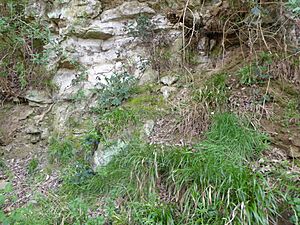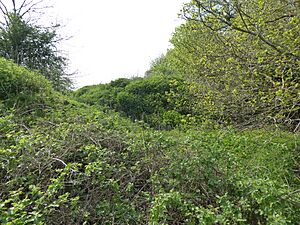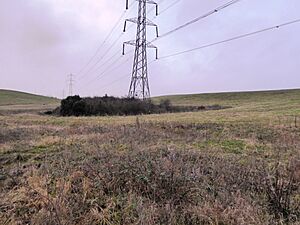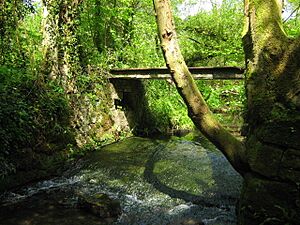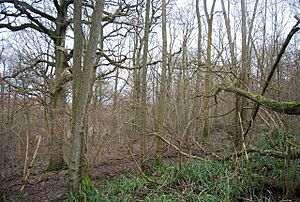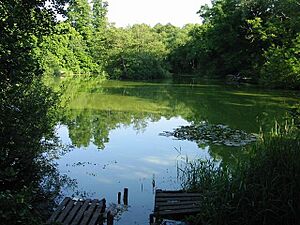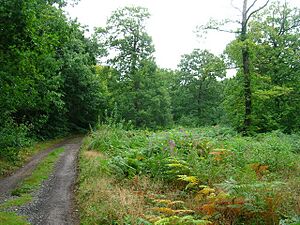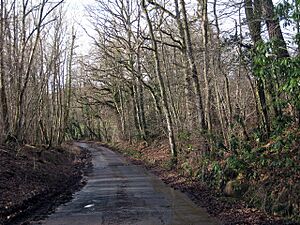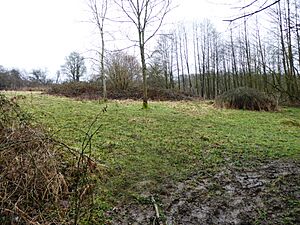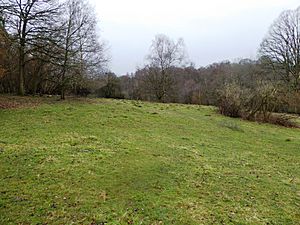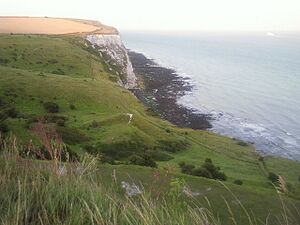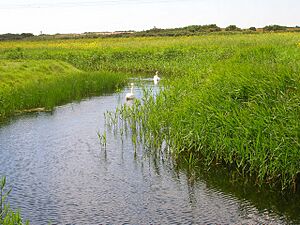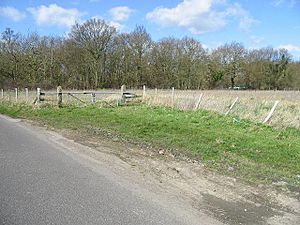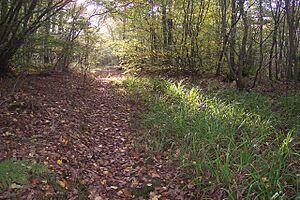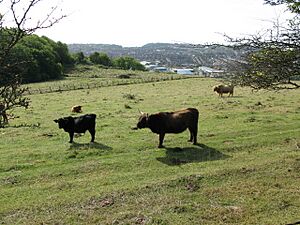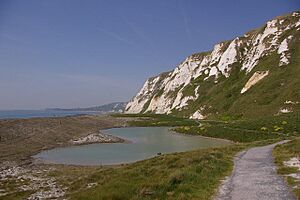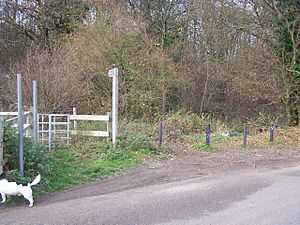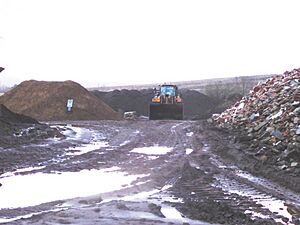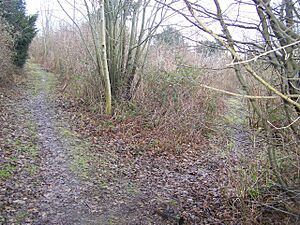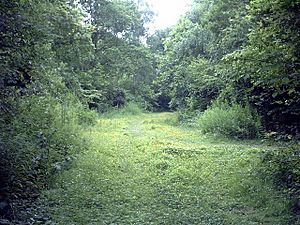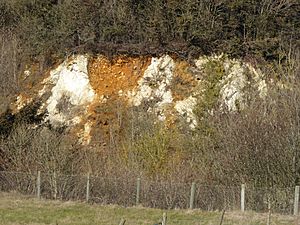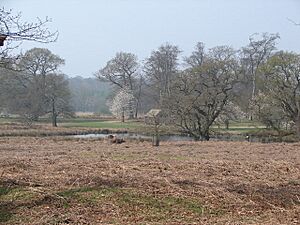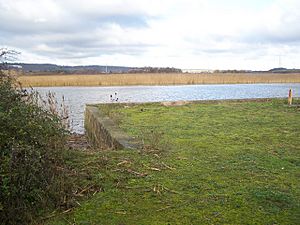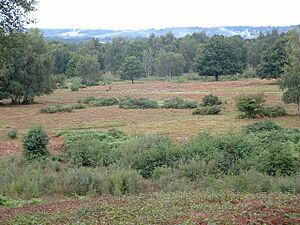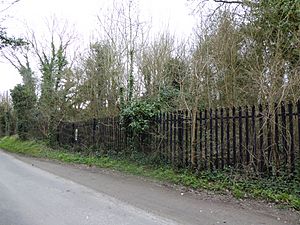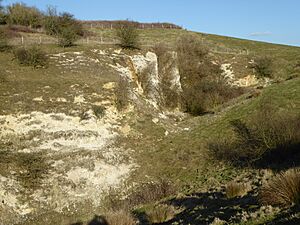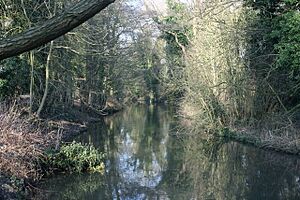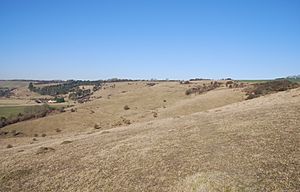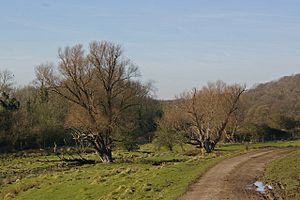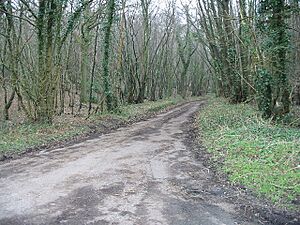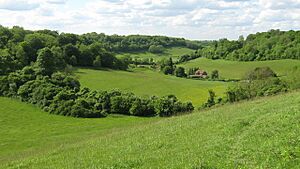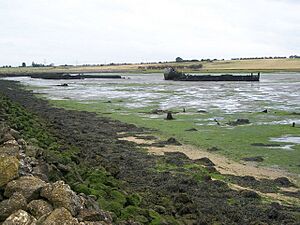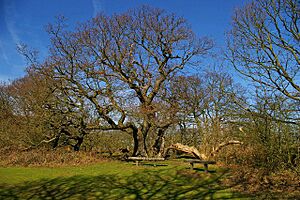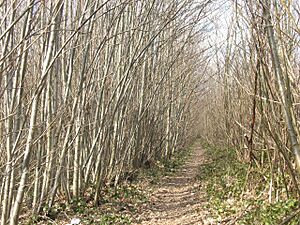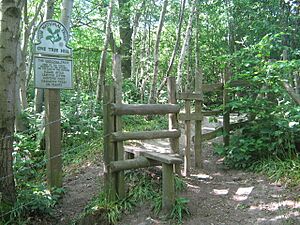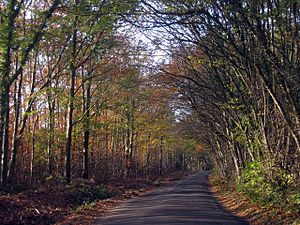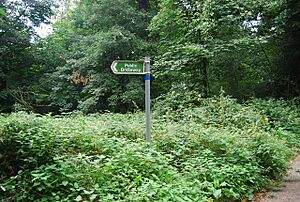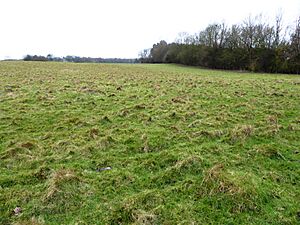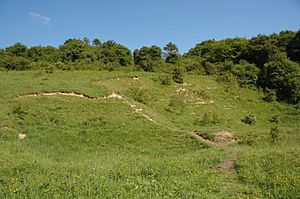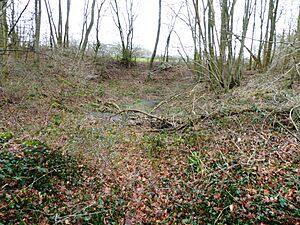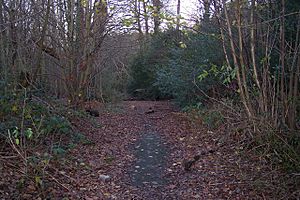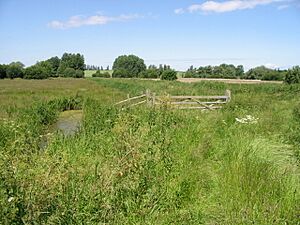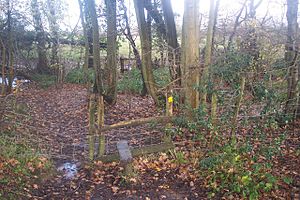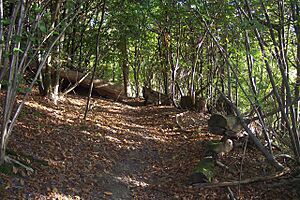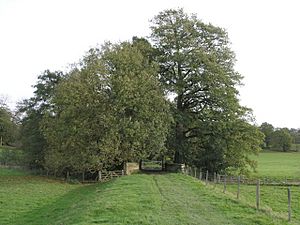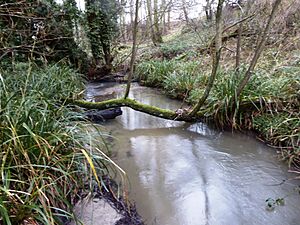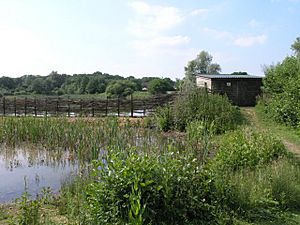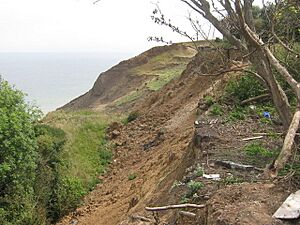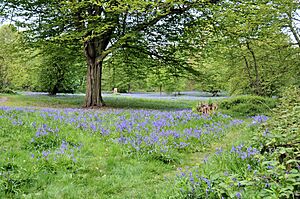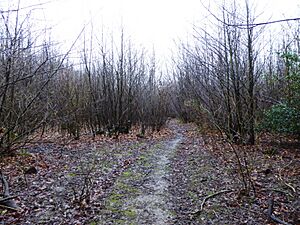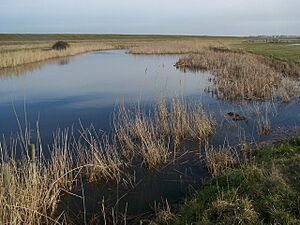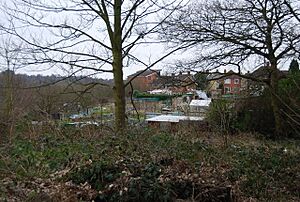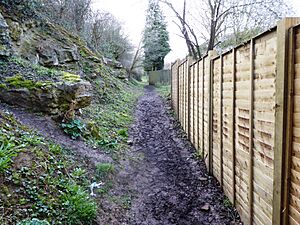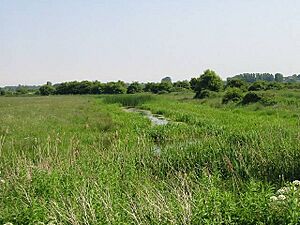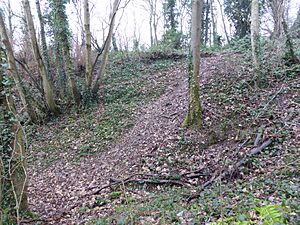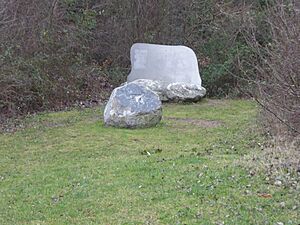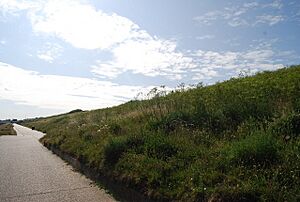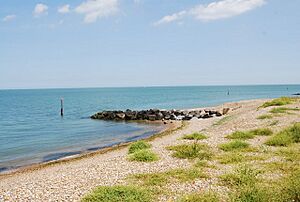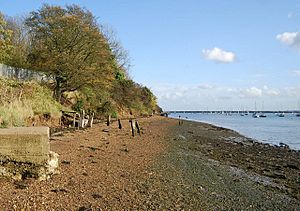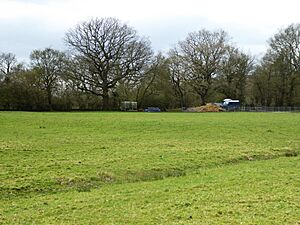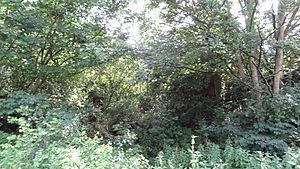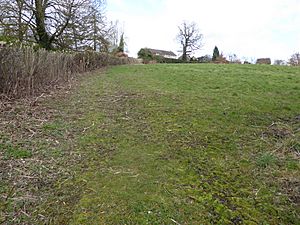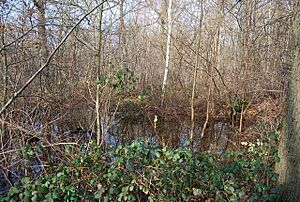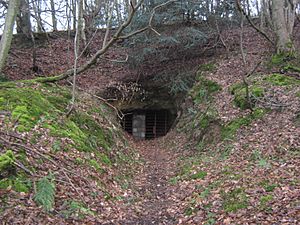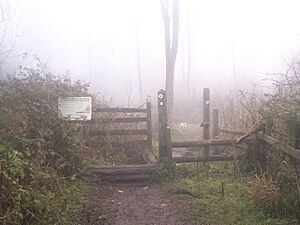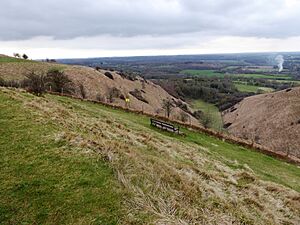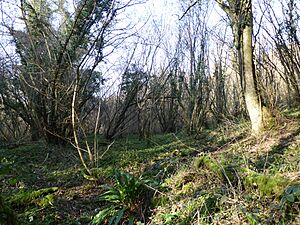List of Sites of Special Scientific Interest in Kent facts for kids
Kent is a county in the south-eastern part of England. It's bordered by Greater London and the Thames Estuary to the north, Sussex and Surrey to the west, and the English Channel and North Sea to the south and east. The main town is Maidstone. Kent has beautiful chalk hills called the North Downs and lovely wooded areas known as the Weald. Its coastline has both flat parts and tall cliffs.
In England, special places called Sites of Special Scientific Interest (SSSIs) are chosen by Natural England. This group helps protect England's nature. When a place becomes an SSSI, it gets legal protection because it's super important for wildlife, plants, or unique rocks and landforms.
As of May 2018, there are 98 SSSIs in Kent! Some are special for their geology (rocks and land), some for their biology (plants and animals), and some for both! Many of these sites also have other important protections, like being Special Areas of Conservation or national nature reserves. Some are even managed by groups like the Kent Wildlife Trust or the National Trust.
Amazing Natural Sites in Kent
| Top - 0-9 A B C D E F G H I J K L M N O P Q R S T U V W X Y Z |
| Site Name | Picture | Why it's Special | Public Access | Location | More Info |
|---|---|---|---|---|---|
| Alex Farm Pastures | This site has very rare grassland that hasn't been changed by farming. Rabbits help keep it healthy by grazing. You can find unusual butterflies here, like the pearl-bordered fritillary. | No public access. | Ashford | Map | |
| Alkham, Lydden and Swingfield Woods | These woods are on steep chalky hills and have a mix of trees and chalk grassland. Look for rare plants like the lady orchid and burnt orchid. | Public access to part of the site. | Dover | Map | |
| Allington Quarry | This old quarry is important for geology. It shows cracks in the rock filled with loess (wind-blown dust). These cracks probably formed during the last ice age when the ground froze and thawed. | No public access. | Maidstone | Map | |
| Aylesford Pit | This site is a geological treasure! Many ancient animal bones and paleolithic (Stone Age) tools have been found here. It helps scientists understand what life was like during the Ice Age. | No public access. | Aylesford | Map | |
| Baker's Hole | This place is famous around the world! It has the most stone tools and flakes from the Early Middle Stone Age (about 325,000 to 180,000 years ago) found in Britain. Many of these tools were made by Neanderthals. | No public access. | Swanscombe | Map | |
| Bourne Alder Carr | The River Bourne flows through this area, making the soil very rich. This helps many different plants grow, including some unusual ones. There's also a swampy area near a fish pond. | Public access to part of the site. | Sevenoaks | Map | |
| Brookland Wood | This wood has many different types of trees and plants. Alder trees grow in wet spots, while hazel, ash, and field maple prefer drier areas. Small streams here are home to various mosses and liverworts. | Public access to part of the site. | Tunbridge Wells | Map | |
| Charing Beech Hangers | This steeply sloped site has old beech and oak trees. Many different plants grow on the ground, including some rare kinds. You might also find unusual insects, like the rare slug Limax tenellus. | Public access to part of the site. | Ashford | Map | |
| Chattenden Woods and Lodge Hill | This site has a mix of old woodlands, grasslands, and scrub. Many nightingales (a type of bird) come here to breed. You can also find rare moths and other insects. | Public access to part of the site. | Rochester | Map | |
| Chequer's Wood and Old Park | This site is special for both its nature and its geology. Fordwich Pit here has many ancient Acheulian handaxes, some as old as 550,000 years! The area also has different habitats like alder woods, grasslands, and ponds. | No public access. | Canterbury | Map | |
| Church Woods, Blean | This woodland has many different trees and plants, plus lots of birds and rare insects. Keep an eye out for the nationally rare heath fritillary butterfly! | Public access to all or most of the site. | Canterbury | Map | |
| Cobham Woods | These woods grow on different types of soil, from sandy to chalky. There's even a field with some unusual plants, like the very rare rough marsh-mallow, which has been here since 1792! | Public access to all or most of the site. | Rochester | Map | |
| Combwell Wood | This is a very old wood. Some parts might have been untouched for thousands of years, holding rare mosses that survived from a warm period long ago. You can also find several rare water beetles here. | Access to footpaths through the site only. | Cranbrook | Map | |
| Cowden Meadow | This meadow is full of plants that grow in grasslands that haven't been farmed for a long time, like quaking grass and oxeye daisy. Wet areas are home to hard rush. | Access to footpaths through the site only. | Edenbridge | Map | |
| Cowden Pound Pastures | This is another rare grassland habitat that is kept healthy by animals grazing. You'll see grasses like crested dog's tail and common knapweed. Wet areas near a stream have water mint. | No public access. | Edenbridge | Map | |
| Dalham Farm | This farm shows how rocks and soil can slowly slide down a gentle hill. It's important for scientists to study how land changes over time, especially where there's no sea erosion. | Public access to part of the site. | Rochester | Map | |
| Darenth Wood | This ancient wood is home to many rare insects. Some beetles here are so rare they are only found in a few places in the country, and they live in dead or dying oak trees. | Public access to all or most of the site. | Dartford | Map | |
| Dover to Kingsdown Cliffs | These famous white cliffs show rocks from 99 to 86 million years ago! They are important for understanding how geology works. Many seabirds nest here, and the seashore has lots of different algae. | Public access to all or most of the site. | Dover | Map | |
| Down Bank | This chalk meadow is a butterfly paradise, with 28 different species, including the rare Duke of Burgundy. You might also spot the endangered black-veined moth and rare plants like man orchid. | Access to footpaths through the site only. | Canterbury | Map | |
| Dryhill | This old quarry shows rocks from about 120 million years ago. It's famous for its many fossils of ancient sea creatures called brachiopods and bivalves, which help scientists study ancient environments. | Public access to all or most of the site. | Sevenoaks | Map | |
| Dungeness, Romney Marsh and Rye Bay | This huge area has many important habitats like salt marshes, sand dunes, and lagoons. It's home to lots of rare and endangered animals and plants. Geologically, it shows how the coastline has changed over time. | Public access to part of the site. | Romney Marsh | Map | |
| East Blean Woods | This wood has a mix of trees, including old oaks. It's a great place to see the rare and protected heath fritillary butterfly and many different woodland birds. | Public access to all or most of the site. | Canterbury | Map | |
| Ellenden Wood | This wood is bursting with life, with over 250 types of plants and 300 types of fungi! You can also find rare insects and mammals like wood mice and dormice. | Public access to all or most of the site. | Whitstable | Map | |
| Farningham Wood | This ancient wood has different soil types, leading to a wide variety of plants and insects. Its ponds are home to several types of amphibians, and a rare hoverfly has been seen here. | Public access to all or most of the site. | Dartford | Map | |
| Folkestone to Etchinghill Escarpment | This large area of chalk grassland has three nationally rare plants: late spider orchid, early spider orchid, and bedstraw broomrape. It also has a key geological site called Holywell Coombe, showing ancient mollusc fossils. | Public access to part of the site. | Folkestone | Map | |
| Folkestone Warren | These chalk cliffs are home to several rare plants and are a nesting spot for many birds. They are also important for studying the Cretaceous period (about 145 to 66 million years ago). | Public access to part of the site. | Folkestone | Map | |
| Gibbin's Brook | This site is mostly marshy grassland with a stream, a pond, and some dry grassland. It's especially known for its many insects, particularly moths. | Public access to all or most of the site. | Ashford | Map | |
| Great Crabbles Wood | This wood has a mix of trees like sweet chestnut and oak. You can find rare plants here, such as lady orchid, man orchid, and bird's nest orchid. | Public access to all or most of the site. | Gravesend | Map | |
| Great Shuttlesfield Down | This grassland is grazed by sheep and cattle, keeping it healthy. It's home to the rare adonis blue butterfly and two types of solitary wasps. | Access to footpaths through the site only. | Folkestone | Map | |
| Greatness Brickworks | This site from the Cretaceous period (the age of dinosaurs!) is full of fossils, especially ammonites. It's super important for studying ancient life in the Weald area. | No public access. | Sevenoaks | Map | |
| Halling to Trottiscliffe Escarpment | This area on the North Downs has chalk grasslands and beech woodlands. It's very important for insects, with rare bugs and the only known place in Britain for a certain moth called Hypercallia citrinalis. | Public access to part of the site. | Rochester | Map | |
| Ham Street Woods | This wood is over 400 years old and has a huge variety of insects, especially those that live in dead wood. You can find 12 rare or scarce species here, including a nationally rare beetle. | Public access to all or most of the site. | Ashford | Map | |
| Hart Hill | This site is a bit of a mystery! It shows rocks from the Pliocene epoch (about 5.3 to 2.6 million years ago). Scientists study the ancient sea shells found here to understand its age. | No public access. | Ashford | Map | |
| Hatch Park | This park has special grasslands that are still managed by a herd of deer. It also has very old trees with lots of unique lichens growing on them. Several ponds here have marshy areas nearby. | No public access. | Ashford | Map | |
| High Rocks | This geological site is famous for its amazing sandstone rock formations, especially the tallest cliffs in the Weald. Scientists study how the rocks here have been shaped by weather over time. | Public access to part of the site. | Tunbridge Wells | Map | |
| Hoad's Wood | This wood is amazing for its insects, especially butterflies and moths. Two types of moths found here, the broad-bordered beehawk and black-veined moths, are nationally rare. Many different birds also breed here. | No public access. | Ashford | Map | |
| Holborough to Burham Marshes | This site is in the flood plain of the River Medway and has many different habitats like reedbeds, grasslands, and woodlands. It's a great spot for birds in winter and has five rare insects, including three types of bees. | Public access to all or most of the site. | Snodland | Map | |
| Hollingbourne Downs | This chalky hillside has untouched grasslands and beech woodlands. You'll find grasses like tor-grass and upright brome, and shrubs like the wayfaring-tree along the edges of the woods. | Public access to all or most of the site. | Maidstone | Map | |
| Hothfield Common | This common has rare heathland and the best valley bog in Kent. Over a thousand insect species have been found here, including several that are nationally rare, like a special bee and a cranefly. | Public access to all or most of the site. | Ashford | Map | |
| Houlder and Monarch Hill Pits, Upper Halling | This site shows layers of rock and soil from the end of the last ice age. It helps scientists understand how the environment changed about 13,000 years ago. | No public access. | Rochester | Map | |
| Hubbard's Hill | This geological site shows how freezing and thawing ice can cause soil and rock to move down hills. The deposits here are from ice ages, some as recent as 12,500 years ago! | Public access to all or most of the site. | Sevenoaks | Map | |
| Ileden and Oxenden Woods | These woods have different soil types and many different habitats. They are home to a rich variety of birds and plants, including two nationally rare orchids: narrow-lipped helleborine and lady orchid. | Public access to all or most of the site. | Canterbury | Map | |
| Knole Park | This park has woodlands, open parkland, and ponds. It's known for having the best ancient woodland insects in the county, including a nationally rare beetle. It also has many different types of fungi. | Public access to all or most of the site. | Sevenoaks | Map | |
| Larkey Valley Wood | This wood has a wide variety of plants, including some rare ones like the lady orchid. It's also a great place for birdwatching, with many breeding birds like tree pipits and hawfinches. | Public access to all or most of the site. | Canterbury | Map | |
| Lenham Quarry | This quarry is important because it shows rocks from the Pliocene epoch (about 5.3 to 2.6 million years ago). There are not many places in Britain where you can see rocks from this time period. | Public access to all or most of the site. | Maidstone | Map | |
| Lullingstone Park | Some trees in this wood are over 400 years old! It's a very important place for insects, lichens, birds, and fungi. Over 340 types of beetles have been found here, including two that are nationally rare. | Public access to all or most of the site. | Sevenoaks | Map | |
| Lydden and Temple Ewell Downs | This site has some of the richest chalk grasslands in Kent. It's amazing for insects, especially butterflies like the marbled white, adonis blue, and the very rare silver-spotted skipper. | Public access to all or most of the site. | Dover | Map | |
| Lympne Escarpment | This steep hillside has woodlands and grasslands with many springs. Because it's close to the sea and humid, plants like stinking iris (which usually grow in woods) can be found in the grassland here. | Public access to part of the site. | Hythe | Map | |
| Lynsore Bottom | These woods have many different tree types and a rich variety of plants on the ground. They are also important for breeding birds like tawny owls and hawfinches. | Public access to all or most of the site. | Canterbury | Map | |
| Magpie Bottom | This steep chalk grassland is home to many different herbs, including the nationally rare Kentish milkwort and seven types of orchids, like the uncommon man orchid. There are also areas of woodland and scrub. | Public access to all or most of the site. | Sevenoaks | Map | |
| Marden Meadows | These meadows are special because they are untouched grasslands that are cut for hay and then grazed each year. They have ancient ponds and hedgerows, with trees like midland hawthorns. | Public access to part of the site. | Tonbridge | Map | |
| Medway Estuary and Marshes | This site is super important for birds, especially in winter. It also has amazing plants, like the nationally rare oak-leaved goosefoot. | Public access to part of the site. | Sittingbourne | Map | |
| Northward Hill | This site has mixed woodland, scrub, ponds, and grassland. It's home to the largest heronry (a place where herons nest) in Britain, with over 200 pairs! You can also find rare moths here. | Public access to all or most of the site. | Rochester | Map | |
| Oaken Wood | This site is a great example of unusual landforms, with cracks and tilted rocks caused by freezing and thawing during the Ice Age. | Public access to all or most of the site. | Maidstone | Map | |
| Oldbury and Seal Chart | Over 250 types of fungi have been found here, including 10 that are rare! It's also home to snails and slugs that are typical of ancient woodlands, like the rare snail Phenacolumax major. | Public access to all or most of the site. | Sevenoaks | Map | |
| One Tree Hill and Bitchet Common | This site has mixed woodlands, some of which are very old. The habitats vary, from acidic soils to damp, rich soils. You can find several rare plants and insects here. | Public access to all or most of the site. | Sevenoaks | Map | |
| Orlestone Forest | Natural England calls this site "nationally significant" for its insects! Hundreds of insect species have been recorded, including 39 that are nationally rare. Some are only found in Britain at this very site! | Public access to part of the site. | Ashford | Map | |
| Otford to Shoreham Downs | These downs have woodlands, scrub, and chalk grasslands rich in different plant species. Even though grazing has declined, it's still very diverse, with over a hundred plants recorded. | Public access to part of the site. | Sevenoaks | Map | |
| Otterpool Quarry | This quarry shows rocks from the Cretaceous period (about 145 to 66 million years ago). It's full of fossil ammonites, which are ancient sea creatures, and helps scientists match rock layers around the world. | No public access. | Lympne | Map | |
| Park Wood, Chilham | This wood has many different trees and plants. It's home to lots of breeding birds and insects, including two rare types: a wasp and a fly. | Public access to all or most of the site. | Canterbury | Map | |
| Parkgate Down | This grassland is grazed by sheep and cattle, keeping it healthy. You can find a variety of orchids here, including the uncommon lady orchid and musk orchid. | Public access to all or most of the site. | Canterbury | Map | |
| Parsonage Wood | This wood is a great example of a woodland valley in the High Weald. It has humid conditions, leading to a diverse range of mosses, ferns, and liverworts. Some plants here show that the wood is very ancient. | Public access to all or most of the site. | Cranbrook | Map | |
| Pembury Cutting and Pit | This site shows rocks from the Early Cretaceous period (about 140 to 100 million years ago). You can find many fossils of an extinct plant called Lycopodites here. | Public access to part of the site. | Tunbridge Wells | Map | |
| Peter's Pit | This used to be a chalk quarry and now has many ponds. Some of these ponds are home to the great crested newt, a protected species. You might also see grass snakes and common European adders here. | Access to footpaths through the site only. | Rochester | Map | |
| Polebrook Farm | The fields on this farm are thought to have looked the same for over 700 years! The hedges and meadows are rich in different plants, with at least 19 types of grasses. | Public access to part of the site. | Edenbridge | Map | |
| Preston Marshes | This site in the River Little Stour valley is mostly covered in common reed, with some willow scrub and pasture. It's a great place for many breeding and wintering birds like reed buntings. | No public access. | Canterbury | Map | |
| Purple Hill | This chalk grassland has many different herbs, including the nationally rare Kentish milkwort and several uncommon orchids. It also has scrub and woods. | No public access. | Maidstone | Map | |
| Queendown Warren | This site has dry grassland and woodland on a south-facing slope. It's home to two rare plants, early spider orchid and meadow clary, and a wide variety of insects. | Public access to all or most of the site. | Sittingbourne | Map | |
| River Beult | The river itself has nearly 100 different plant species! You can see floating plants like yellow water-lily in the water and plants like amphibious bistort on the banks. | Public access to part of the site. | Tonbridge | Map | |
| Robins Wood | This deep valley along a stream in the Weald is very humid, which helps many mosses, ferns, and liverworts grow. The woodland here is thought to have been around since the last ice age ended, about 11,700 years ago. | Access to footpaths through the site only. | Cranbrook | Map | |
| Rusthall Common | This geological site is important for showing how sandstone rocks weather and change. Look for Toad Rock, which has a narrow base shaped by ancient winds and ice. | Public access to all or most of the site. | Tunbridge Wells | Map | |
| Sandwich Bay to Hacklinge Marshes | This site is incredibly rich in nature, with over 30 plant species and 168 insect species that are nationally rare or scarce! Many birds spend the winter here. It's also geologically important, with ancient fish fossils from about 57 million years ago. | Public access to part of the site. | Sandwich | Map | |
| Scord's Wood and Brockhoult Mount | This sloping site has some of the best sessile oak forests in Kent. The grasslands on acidic soils have plants like common bent and heath bedstraw. | Public access to part of the site. | Westerham | Map | |
| Scotney Castle | This site has parkland, grassland, and woodland. It's home to dormice, which are a protected species. You can also find several nationally scarce insects, like a rare door snail. | Public access to all or most of the site. | Tunbridge Wells | Map | |
| Seabrook Stream | This site is special for its 67 species of cranefly found in its wet areas. Four of these craneflies are nationally scarce, and one is only known in two other places in Britain! | Public access to part of the site. | Folkestone | Map | |
| Sevenoaks Gravel Pits | This site has flooded gravel pits that attract many breeding and wintering birds. You can find thirteen different species of dragonfly here, along with reedbeds and woodlands. | Public access to part of the site. | Sevenoaks | Map | |
| Sheppey Cliffs and Foreshore | These cliffs show rocks from the Eocene epoch (about 56 to 34 million years ago) with amazing fossils of ancient animals and plants, including tropical vines! It's also important for a nationally rare plant called dragon's teeth. | Public access to part of the site. | Sheerness | Map | |
| Shorne and Ashenbank Woods | These woods are important for their many different insects, especially dragonflies, beetles, and true bugs. Some rare beetles are found here. Old clay workings have been turned into ponds for wildlife. | Public access to all or most of the site. | Gravesend | Map | |
| Sissinghurst Park Wood | This wood is mainly sweet chestnut trees. It's special because of the many rare plants found along its paths. It's the most eastern place in Britain where the ivy-leaved bellflower grows. | No public access. | Cranbrook | Map | |
| South Thames Estuary and Marshes | Over 20,000 waterfowl use this site, and some species are found in internationally important numbers! There are rare plants along the ditches and many different insects, including nationally rare beetles and flies. | Public access to part of the site. | Rochester | Map | |
| Southborough Pit | This site shows rocks from about 140 million years ago. It's the main place where a special ancient soil bed, containing fossils of an extinct plant, was first studied. | Public access to part of the site. | Tunbridge Wells | Map | |
| Spot Lane Quarry | This site shows layers of loess (wind-blown dust) from the Ice Age, about 352,000 to 130,000 years ago. It's one of the few places in Britain where you can study fossils of land snails in loess. | Public access to all or most of the site. | Maidstone | Map | |
| Stodmarsh | This site has flooded gravel pits, reed beds, and grasslands, with a wide variety of plants and animals. Several rare moths have been found here, and two rare birds, cetti's warbler and the bearded tit, breed here in large numbers. | Public access to part of the site. | Canterbury | Map | |
| Sturry Pit | This old gravel quarry has yielded many ancient hand axes from the Stone Age. It's important for understanding the history of the Thames river basin during the Ice Age. | Public access to all or most of the site. | Canterbury | Map | |
| The Swale | This site has mudflats, salt marshes, and freshwater marshes. It's home to many wildfowl and wading birds, including internationally important numbers of teal and wigeon. It also has a rich variety of insects and plants. | Public access to part of the site. | Faversham | Map | |
| Swanscombe Skull Site | This site is famous because in 1935, a dentist found part of a 400,000-year-old skull here! It belonged to an early Neanderthal woman and is one of only two places in Britain where such ancient human remains have been found. | Public access to all or most of the site. | Swanscombe | Map | |
| Tankerton Slopes | This slope has a large population of hog's fennel, a nationally rare plant. It's also home to a nationally rare moth whose caterpillars only eat hog's fennel! | Public access to all or most of the site. | Whitstable | Map | |
| Thanet Coast | This coastline has cliffs, foreshore, salt marshes, and lagoons. It's important for many wintering birds and three nationally rare insects. It's also a key site for studying ancient rocks and plants from about 56 to 34 million years ago. | Public access to part of the site. | Birchington | Map | |
| Tower Hill to Cockham Wood | This site has woodlands and sandy areas with many different insects, including seven nationally rare bees and wasps. Upnor Quarry here shows a full sequence of ancient rocks. | Public access to part of the site. | Rochester | Map | |
| Trottiscliffe Meadows | These meadows are rare examples of untouched grasslands in Kent. They have many uncommon plants like marsh valerian and a rare moss. | Access to footpaths through the site only. | West Malling | Map | |
| Wansunt Pit | This site is important for understanding the Ice Age history of the Thames river. Stone tools made by early humans (Homo heidelbergensis) from about 424,000 to 374,000 years ago have been found here. | Public access to part of the site. | Dartford | Map | |
| Wateringbury | This site has a special type of rock called tufa that shows a complete record of ancient snails. It helps scientists understand how different species moved into the area after the last ice age ended. | No public access. | Maidstone | Map | |
| West Blean and Thornden Woods | These woods are home to over fifty species of breeding birds and many different insects, including five nationally rare and thirteen nationally scarce types. You can also find the protected hazel dormouse here. | Public access to part of the site. | Herne Bay | Map | |
| Westerham Mines | The main reason this site is special is because five different species of bats use these old mines to hibernate! Some moths also spend the winter in the mines. | Public access to part of the site. | Westerham | Map | |
| Westerham Wood | This ancient oak wood is managed in a traditional way. It has a wide variety of plants on the ground and many different breeding birds. You can also find lots of insects, mosses, and fungi here. | No public access. | Westerham | Map | |
| Wouldham to Detling Escarpment | This chalky hillside has woodlands, untouched grasslands, and scrub. You can find the nationally rare meadow clary plant and several scarce insects. It's also known for its many well-preserved fossil fish from the Mesozoic Era (the age of dinosaurs!). | Public access to part of the site. | Chatham | Map | |
| Wye and Crundale Downs | This site has many different habitats, including grasslands, wet meadows, scrub, and woodlands. The Devil's Kneading Trough, found here, is an important geological spot showing changes from the last ice age. | Public access to part of the site. | Ashford | Map | |
| Yockletts Bank | This sloping woodland on dry chalky soil is home to many different woodland birds. The ground is covered in bluebells and many types of orchids. | Public access to all or most of the site. | Canterbury | Map |
See also
- List of Local Nature Reserves in Kent
- Kent Wildlife Trust
Sources





